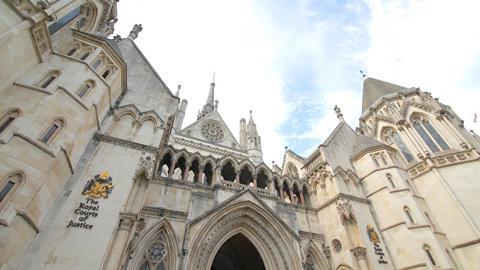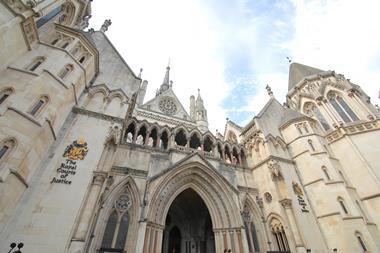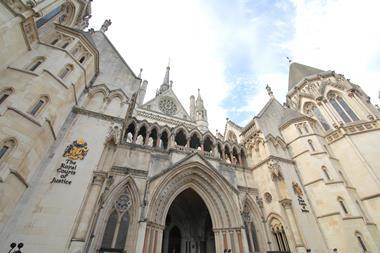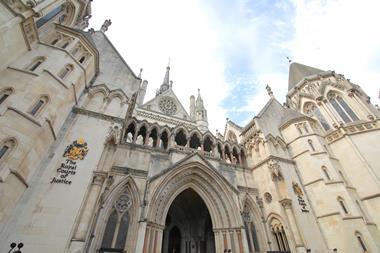A test case brought by the FCA against eight insurers could have significant consequences for insurers, brokers and policyholders. We report on the latest from the High Court…
16.50: That’s it for today - the case will resume on Monday at 10am with the continuation of RSA’s defence.
16.48: Vicinity means ‘close to’ - does not have a set definition for this within RSA wordings.
16.45: RSA accepts that advice from a public authority and correlating closure measures prevented use, but did not hinder access. Accept that Covid-19 was a general health emergency, but these are not insured - only health emergencies, likely to affect life, that are within the proximation of the premises.
16.41: What is not covered, starts with a time deductible said Turner. Restricts cover to the period of inaction.
16.39: In RSA2, the peril is damage.
16.35: Lord Justice Flaux clarifies that you can only have cover due to a manifestation of disease within a set geographical location - don’t need to get to counter factuals at all? Turner - the answer is no until a situation such as Leicester arises.
16.31: Turner also cited the example of holiday-makers depending on a train from Paddington to Penzance - after government advice not to use public transport, this holiday booking was cancelled, but was not the result of the business closing or being restricted, but was instead because of government guidance on public transport.
16.25: Closure or restrictions placed on premises by 26 March only are valid - earlier advice is insuffiencient. Turner gives an example that social distancing and quarantine advice was circulated prior to orders to close businesses, so any cancelled bookings prior to 26 March are not the result of closure or restirctions as the business is still open - it is a personal choice by customers at that point.
16.22: FCA said that manifestation is the same as occurance, but Turner said this is wrong. They have used the word ‘manifesting’ deliberately - the disease has to be apparent and result in the closure of property or restrictions. It is ridiculous that an unknown episode of Covid-19 would trigger this proximate causal test. Deprives the word ‘manifesting’ of any meaning.
16.20: There has to be a notifible disease at the premises or within 25 miles of the premises. That disease has to manifest itself and the manifestation of the disease has to result in closure or restrictions placed on the premises. Link between the peril and the loss. This requires proximate causation - both as the cause of the loss and the cause of the restrictions. The same words can’t have two different meanings.
16.17: RSA’s BI extension clause, already had the BI perils set out, as well as references to property damage - this is followed by discussing settlements and the primary insuring clause said Turner. This then sets out the machinery for quantification, referring to gross revenue. There is a material damage requirement too. Treating perils as if they are damage.
16.16: Method of quantification of loss - loss of gross revenue is the only way to quantify here. Turner said policyholders have to accept the extensions and the quantifications applied.
16.14: RSA’s BI cover, what is insured - loss of gross revenue. This is a defined term, said Turner. The actual reduction in the loss of gross revenue based on the damage to buildings only during the indemnity period. Mr Justice Butcher said these policies are poorly drafted.
16.12: Each adjustments clause should be construed in terms of its language, and should apply to non-damage losses.
16.09: Turner said that FCA’s approach is wrong, that non-damage should not be assumed to be the same as ‘Damage’, which is outlined in the policy definitions. The issue is a simple one of construction, said Turner - construing that the BI cover is extended beyond the primary cover. Parties were treating the non-damage clauses as if they were damage for the sake of quantification.
16.07: Turner talks about ‘Damage’ - said that none of RSA’s clauses can apply to the quantification of losses under a non-damage extension to BI cover.
15.58: An attempt by the FCA to abolish the rule of the proximate clause to unleash the remoter causes and introduce the concept of material contributions into the law of insurance. This approach would have nothing to do with the test of proximate cause, said Turner.
15.55: The wording in RSA3, loss following a notifible disease within 25 miles, that requires a proximate causal relationship. The question here is whether the occurance of Covid-19 within 25 miles has been the dominant cause of the loss, asked Turner. This does not take into account the remoter causes of the loss.
15.52: Policyholders are required to demonstrate a proximate causal link between the loss and the closure/restrictions. Lord Justice Flaux responds to Turner, saying that if the policies are as broad as the FCA states, it’s completely pointless other than as a trigger or a box to be ticked that there has been a case in a set distance. Turner said it goes against every grain of an indemnity policy. The assumption from the start has been that under an indemnity policy you are covering the loss caused in a particular way.
15.48: The creation of a postcode lottery. FCA and Edey QC did not describe a commercial purpose yesterday. The proviso is there to ensure that the insured can rebuild premises and bring period of interruption to an end and reduce exposure to insurer. Turner is not surprised by the FCA’s ‘infected’ approach to the proximity clause.
15.44: It is plain that Lord Sumner is drawing a distinction - contracts of chance versus indemnity. Turner said many of us have been standing too near to the trees to see the wood. He added that the FCA cannot treat the proximity clause as a happenstance.
15.42: Has the event on which I’ve paid my premium occurred? Turner said the FCA misread the details from Lord Sumner on indemnity.
15.40: ’Epitomy of happenstance’ - no reason why the FCA draws the line at a one-mile proximity to the insured premises said Turner.
15.36: The commercial rationale for these provisions is obvious, said Turner. People may be less willing to visit premises within the relavant area, or less willing to be economically active here, impacting the insured business. The likelihood of individuals’ behaviour being affected will increase as the distance from the insured premises decreases - insurers’ approach to relevant perils is not uncommercial. Turner agreed with the bread and butter disease outbreak example given by Lord Justice Flaux.
15.33: Proximity requirements have formed part of most of the insurers’ wordings; this is a specifically defined term within RSA4. Kealey said this proximity requirement is stipulated is integral part of insured peril and that the FCA should not look outside of this to identify peril. The FCA dislocates peril from the proximate clause, said Turner.
15.31: For BI, the peril is the notifible disease. Peril is the reference to a danger - for example to the insured’s gross profit. Turner says Hiscox may not agree, but the words ’interruption’ or ‘interference’ do not add to the policy, they are the ‘coathanger over which the cover is draped’.
15.30: Turned cites law which states that it is an offence to fail to comply when asked to leave a cordoned area, set up by the police.
15.27: David Turner QC picks up the mantle next.
14.36: There’s nothing wrong with the policy language as such, but one thing is very clear - that the FCA’s case that the insureds were insured against infectious diseases generally, that is simply not right - Kealey
14.34: Interdependent causes (of the peril) require that each pass the ‘but for’ test otherwise there is no coverage. If they are independent causes, it’s the same. If that cannot be proved, then the insured fails on the burden of proof - Kealey
14.19: QC Kealey is focusing on case law at the moment, particularly a case relating to BI losses incurred from 9/11. the case involved cruise ship company Silversea Cruises. Lord Flaux - the judge on the current case - was the QC for Silversea in that case
14.06: He is essentially arguing that the FCA case centres on something that did not cause the loss leading to the actual loss (customers not coming into premises/churches/etc)
14.05: Ecclesiastical QC Gavin Kealey says the FCA cannot link an indirect cause with a direct cause (for the insured peril)
14.00: The court is back in session
13.00 The court will now break for lunch and return at 1.55
12.57 Speaking of “multiple wrongdoers” Kealey says looking back at the Kuwait Airways case - because the loss was only partially covered by both clauses there was a breach of clauses, the insurer Generali therefore was in breach of contract, to apply the ”but for” test to this - the wrongdoer cannot rely on applying the same wrong
12.55 Kealey deems ”FCA wholly inappropriate and quite wrong” to think BI is the same as insured peril, event is the cause of the insured peril but it is not the insured peril
12.46 Kealey looks back at the case of Hurricane Katrina stressing ”Damage with a capital D,” he adds that this is insured as having been caused by whatever risk falls within all risks, ”this is fallacious”. The relevant damage is the peril and not the cause of that damage, the court is only concerned by the “damage” not the cause of that damage or otherwise
12.43 Following this, the FCA has acknowledged in its argument that any happening in a particular area was “causative” of the government response to Covid-19, so no causation can be proved
12.39 ”We are not guilty, the guilt lies elsewhere” - this argument is not right Kealey says and questions, if the gov imposes restrictions disease on all areas, then the insured does not have the coverage?
12.37 BI losses caused to an insured by a disease during a pandemic are recoverable so long as cover extends into the stated radius according to FCA, but there is no insured peril clause in any of the insurance contracts Kealey highlights. The insurer then is confronted by a disease on that has been on an epidemic scale
12.31 Lord Justice questions the closure of the church- how do you distinguish closure from Covid-19 or fear of the virus or something else?
12.29 Business interruption (BI) losses are very ”complicated and notoriously difficult” to calculate and this is why loss adjusters are heavily engaged in all instances Kealey says, he gives the example of the closure of a church suffering a 20% loss-how do you prove where this loss comes from?
12.25 The insured has to prove that the restriction was not imposed Kealey says
12.24 Lord Justice says this point is neither here nor there
12.19 When you have identified the insured perils and there is no legal or principal reason. For the insured caught up in wide area disease, all you need according to FCA is disease in a relevant area for it to actually exist, “so long as there is one case of Covid-19 in 25-mile area the insured can recover all losses cause by pandemic” Kealey highlights
12.15 The argument that the FCA makes in its trial skeleton is ”logic loss has no cause”, the FCA said the loss has no peril in its transcript, Kealey adds this is a “non-answer”. The only time this is relevant is if the other legal cause was a ”breach of cause” ie: two wrong doings, then the law recognises that both cannot escape liability
12.07 Insured perils and proximate cause-if one is excluded the “but for test” cannot be satisfied Kealey adds
12.04 Two stages in this - is the disease causing this? And once identified peril is that the proximate cause? Kealey says
12.03 When the contract insures against loss for both the parties, you have to construe these contracts from the date they were made, the parties are adopting traditional causal analysis not replacing it, Kealey says
11.57 Kealey referred to QBE argument, he said that there is fundamental causation here, would the government have done the same irrespective of the insured? If one takes a basic disease cause Kealey adds that he would expect there to be coverage giving the local Leceister lockdown as an example, read more here
11.54 The idea put forward by the FCA is in itself a fantasy says Kealey, the insurers have to treat exaclty the same way as the insured meaning “fairly”
11.52 Kealey stressed that if you have one instance of illness within a 25 mile radius - the question you have to ask is do you have a business interruption loss?
11.47: Kealey argues that insurers are only covering diseases within the limit that directly cause a loss, not diseases more widely that cause a loss
11.44: Insurers are ‘simle people’ Kealey says, and that is why they apply the ‘but for’ case
11.42: Now Kealey argues that the illness in the relevant policy area needs to be ‘factually causative’
11.40: Kealey says that the FA’s argument of removing more than the insured peril to get more coverage is ‘antithetical’ to common sense
11.37: But Lord Justice Flaux says it may be ‘impossible’ to determine the reason behind a customer not visitng the premises. Kealey says he does not have the answer to that question
11.36: Mr Justice Butcher says this is ‘the heart of the issue’
11.31: Journalists are involved now. Kealey argues that in the case of a shop shut down for a rat infestation, if a journalist wrote an article on the infestation, then the policy would not pay out in full, because the counter factual would not remove the rats, and therefore the journalist’s article would cause ‘disinclination to visit’ among the public and would have caused the loss anyway. Therefore, Kealey argues, the pay out would be reduced due to the downturn in business as a result of the public having knowledge of the rats
11.28: Edelman ’completely fallacious’ in his assertions, Kealey says
11.27: Kealey says that the FCA must’ve got the counter factual wrong, because you cannot have the same counter factual for every policy in the test case, as Colin Edelman QC argued on there behalf
11.25: Kealey disputes that insurance law is different to contract law as the FCA has previously claimed
11.14: Kealey says that the FCA has put to one side legal principles as if they dont exist
10.58: Kealey says the real question is: is there an insured peril, and has that peril caused that loss?
10.56: Lord Justice Flaux questions how this is the case, unless the insured cause is not sufficient to be a proximate cause
10.53: Kealey says that interdependent clauses are based on the but for test, so if one interdependent cause is covered and one is uninsured you are covered for the loss. But with independent causes, if one is an insured peril, you have no coverage, because but the other independent cause would have caused the same loss
10.39: Kealey argues that the FCA’s counter factual bears no resemblance to any of the insured wordings involved in the case
10.35: The FCA’s case is that their is a ‘single proximate cause for everything relevant to this case’, but Kealey argues that the insurers’ wordings contain no insured peril that fits that description
10.33: And now it’s Gavin Kealey’s turn to present the case for all of the insurers in the case on the ‘fundamental principles’ on causation in insurance
10.32: Lynch QC says Hiscox’s wording on public authority ‘treads an uncommercially and unrealisticly narrow path’
10.17: HAG counsel Lynch QC points out a number of Hiscox policy clauses that are more specific clauses in the policy that give rise to ‘oddities’ and argues how Hiscox’s own construction of its policy wording contradicts other areas of the policy
10.15: Lynch argues that the restriction of access imposed by the government’s lockdown is enough to trigger the Hiscox policy, and says the insurer cannot now re-define its wording to suit
10.10: Lynch QC says that Hiscox’s policy wording is ‘deliberately broad and non-specific’ and as such leaves the application of the clauses up to judegement
10.05: Lord Justice Flaux agrees that unless a business has just one supplier and one customer, it is unlikely that any business interruption would be a total closure and later restart
10.04: Hiscox argues that interruption has a narrow definition such as a complete stop of a business and later restart, but Lynch argues that is too restrictive a definition, and that the wording should actually apply more widely, citing increased running costs as just one area where Hiscox’s policy applies beyond this narrow definition
10.02: Lynch QC says the words in Hiscox’s policies could have more than one meaning, not just the definitions used in the insurer’s defence
10.00: Another early start today as Ben Lynch QC takes on the Hiscox wording on behalf of the Hiscox Action Group
Missed yesterday’s proceedings? You can catch up on all the action from the third day of the hearing here.

12.43
FCA business interruption test case
- 1
- 2
- 3
- 4
 Currently reading
Currently readingFCA business interruption test case: Day 4 - as it happened
- 5
- 6
- 7
- 8




















































No comments yet